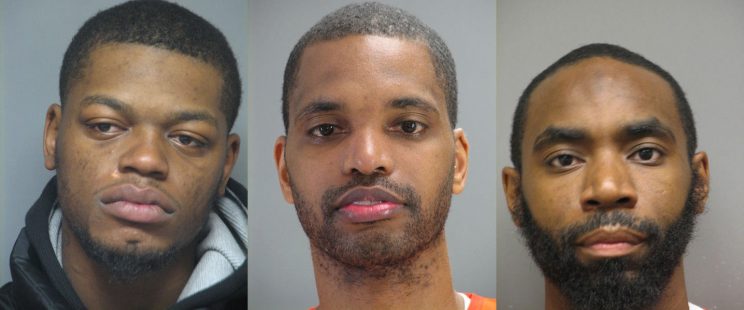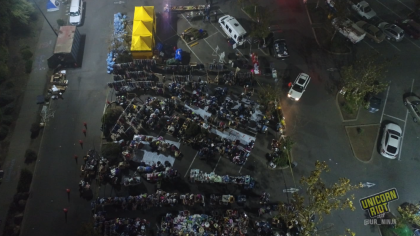Delaware Vaughn Prison Revolt Trial Ends In Mixed Verdict
Wilmington, DE – The trial of three prisoners accused of involvement in a February 1, 2017 prisoner uprising at the James T. Vaughn Correctional Center finished testimony and closing arguments last week. After a trial lasting about a month, jurors began deliberations on Friday, November 16, and reached a verdict Tuesday afternoon.
In what has become known as the Vaughn Uprising, prisoners took over Building C at the Vaughn prison in Smyrna, Delaware, and took three prison guards and one prison counselor hostage. Demands issued during the hostage standoff included that Delaware Governor John Carney investigate poor living conditions at the facility. One correctional officer who was taken hostage, Steven Floyd, would later be found dead after police re-entered the facility.
On the afternoon of Tuesday, November 20, jurors in the case returned a verdict, according to the Delaware News-Journal:
After a nearly four-week trial, a New Castle County jury found Dwayne Staats guilty of first-degree felony murder, first-degree murder of a law enforcement officer, kidnapping, assault and conspiracy.
Staats was found not guilty of intentional murder in the first degree.
Jarreau Ayers was found not guilty of any of the three murder charges but guilty of kidnapping, assault and conspiracy.
Deric Forney was found not guilty of all charges against him and is set to go free. – Delaware News Journal, November 20, 2018
Below is Unicorn Riot’s full report on the evidence and testimony made in the first Vaughn Uprising case.
Read our first report from the trial, covering opening arguments, here.
The three defendants in the first trial group were charged with riot, three counts of murder in the first degree (Delaware law allows prosecutors to charge multiple counts based on the same murder), two counts of assault, four counts of kidnapping, and conspiracy to commit riot. 13 other defendants from the uprising are also slated to face trial throughout 2019.
A cooperating defendant, Royal Downs, was also indicted on lesser charges and still awaits trial and sentencing, with results presumably depending on how pleased prosecutors are with his performances at trial.

Judge William Carpenter’s courtroom held a tense, electric energy at times as two of the defendants – Jarreau Ayers and Dwayne Staats, both of whom represented themselves in court and are already serving life sentences for previous murder cases – each took the stand to testify on their own behalf. Both men denounced the conditions in Vaughn, mocked the contradictions in the prosecution’s evidence, and refused to implicate other prisoners they knew to be involved in the takeover.
It is unclear what punishments the court could impose against the two men, since they both already are sentenced to life without the chance of parole. Conservative Delaware lawmakers recently failed to reinstate the death penalty, which the state’s Supreme Court effectively abolished in 2016. Jarreau Ayers told jurors that the Department of Corrections could still retaliate against them by essentially keeping them in solitary confinement, or “the hole“, for the rest of their lives.
The two men representing themselves added an explicitly political element to the case, allowing details and opinions about prison life to come up in court that probably wouldn’t have been mentioned otherwise. In his closing argument, Jarreau Ayers thanked Judge William Carpenter, saying that Carpenter had been highly conscientious in allowing himself and Dwayne Staats a wide latitude to defend themselves in court. Both men were provided with standby counsel, lawyers who did not represent them but directly assisted them in matters such as evidence and motions.
The third defendant, Derric Forney, serving an 11-year robbery sentence, was barely mentioned at all by the prosecution. A few inmate witnesses claimed to have seen Forney attack and handcuff corrections officer Joshua Wilkinson, although other state’s witnesses testified that they saw the entire attack and Forney was not involved. Forney was represented by defense lawyer Ben Gifford. Forney himself took the stand to say that he was not involved in the uprising. He also shared his trauma of being brutalized by officers who he said went cell to cell violently beating and pepper-spraying inmates after police retook Building C. In closing arguments, Assistant Attorney General John Downs seemed to gloss over the lack of evidence against Forney by calling him a “soldier” in contrast to Ayers and Staats, whom he cast as “leaders“.
A fourth defendant, Roman Shankaras, who prosecutors had accused of being the “mastermind” behind the uprising, had been a part of this first trial group but was later severed from the case. He is expected to face trial sometime in 2019.
While the state showed jurors mountains of evidence, very little of it was tied directly to the defendants. Among primary pieces of evidence against both Jarreau Ayers and Dwayne Staats were radio recordings from the hostage negotiations, in which both men’s voices can be heard. Prosecutors have also used a letter from Dwayne Staats to another inmate, seized during a cell search, in which he appeared to take responsibility for organizing the revolt. Another letter from Roman Shankaras to Royal Downs, an influential prisoner involved in the uprising who later flipped and became a state’s witness, was cited as evidence of a conspiracy.
One defining element of the case is a total lack of any video evidence from inside Building C; no surveillance cameras existed inside Vaughn’s Building C at the time of the uprising when the building was taken over. Some video of inmates and hostages being released from inside the building were filmed by a state police bomb squad robot in the yard outside the building, but no defendants could be seen in the video. Another video the state played for the jury showed police in SWAT gear entering the building during their operation to retake Building C. However, none of this footage showed any of the defendants and offered little insight as to what exactly happened inside Building C.
Some physical evidence was introduced by the state, such as various shanks, fire extinguishers, and mop wringers allegedly used as weapons to subdue prison guards who were taken hostage. However, Delaware State Police Sergeant Andrew Weaver, the main investigator in the Vaughn case, would admit under cross-examination that only some items were sent for forensic DNA testing. Weaver appeared unable to give an explanation for this inconsistent testing of evidence, with untested items including several shanks as well as blood-soaked gloves. Weaver repeatedly denied responsibility for deciding which items were tested, instead referring to the “collaborative effort” by the prosecution team of which he is part.
Sergeant Weaver also told the defense that he only sent in for DNA testing items which he believed to have been used in the attack on Sergeant Floyd. Weaver was unable to offer an explanation as to how he could determine, before testing, which items had or had not been used in the attack. Assistant Attorney General John Downs suggested that some items had not been sent for forensic testing due to concerns about high cost, but multiple state forensic technicians who later testified denied that cost was a consideration in testing evidence for the case. Jarreau Ayers asked Weaver if it was true that “you just left five shanks and a pair of bloody gloves off the list” of evidence to be tested in a case involving the murder of a corrections officer. Weaver did not deny that he left those items off of his list of what was sent for testing.
Other issues with evidence used by the prosecution included a map that jurors were told represented the layout of Building C and showed where pieces of evidence, such as shanks, were recovered. However, upon cross-examination, a state investigator admitted that the map, which he had claimed was simply “not to scale“, in fact left out an entire portion of the building. The defense also pointed out how many evidence items were misrepresented on the map, being shown as found in locations other than where they were actually recovered. Prosecutors quietly dropped any further use of the map from the rest of their case, although Ben Gifford, defense counsel for Derric Forney, referenced it in his closing arguments, calling it a “gem” and reminding jurors that the state had made a false representation of the evidence.
With a total lack of video evidence from inside the prison, and inconsistent testing for DNA and fingerprints, the prosecution’s case relies almost entirely on cooperating inmate witnesses. The state’s primary cooperating witness, Royal Downs, is alleged by the defense to have been an influential gang leader within the prison. At one time, Royal Downs was romantically involved with a female correctional officer who was working at Vaughn, who was eventually fired over her relationship with Downs. Opening arguments by Jason Antoine, defense counsel for Roman Shankaras (who ended up getting severed from the first trial group) alleged that Downs himself could have been the one to order the killing of Sergeant Stephen Floyd.
Several inmate witnesses for the state, including Royal Downs and Walter Smith (aka Abdul-Hafid Al-Salafi), gave the prosecution the kind of evidence they sought, namely claiming that all three defendants were involved in one way or another in the actual assaults on correctional officers. However, other inmate witnesses for the state contradicted much of this testimony.
For instance, Al-Salafi claimed that he saw one of the defendants assault a correctional officer because he was on the phone in the prison’s barber shop at the time, where he was able to see the incident through a window. Other state’s witnesses, such as prisoner Anthony Morrow, testified that they were in the barber shop using the phones at that same time and that Al-Salafi was not there. Notably, no phone records were produced by the state to prove that Al-Salafi even made a call from that phone at that time. State police detective David Weaver admitted under cross-examination that his investigation had pulled records of thousands of prison phone calls from Vaughn, and that he was not aware of any instance of DOC phone records going “missing“.
The defense claims that Al-Salafi, like other cooperating witnesses, is fabricating his testimony in order to curry favor with the Department of Corrections. While prosecutors claimed they had promised inmate witnesses no favors, defense counsel Ben Gifford pointed out the constant courtroom presence of several Delaware DOC officials, who he said easily had the means to reward prisoner witnesses with better living conditions in return for helping them “get justice for their brother” Steven Floyd, the guard hostage who died.
Delaware DOC Commissioner Perry Phelps, Deputy Commissioner Alan Grinstead, Bureau of Prison Chief Steven Wesley, and other state prison officials have been a constant presence at the trial, often taking up an entire row. Many of them were seen actively texting on their phones while inmate witnesses were testifying. Daniel Masi from the Criminal Intelligence section of the Delaware Department of Justice has also been seen in attendance.

During his closing arguments, Assistant Attorney General Downs admitted that Building C after the uprising was “a large, contaminated crime scene” and tried to downplay the significance of the inconsistent DNA testing done by investigators in the case. Downs instead asked jurors to rely on eyewitness testimony, saying “this case is about what the witnesses said“, apparently ignoring the blatant contradictions in different versions of events that had been offered by state’s witnesses.
According to the prosecution’s summary of their case in closing arguments, Ayers is guilty because he knew about “the plan“, he told inmates to remove locker boxes from their cells to be used to barricade doors, he “was a shotcaller” among prisoners, and allegedly had keys he was using to let prisoners out of their cells.
The case against Dwayne Staats largely relied on Staats’ own testimony in which he admitted to planning the uprising and taking Counselor Patricia May hostage. Assistant Attorney General Downs also claimed that cooperating witnesses saw Staats with a shank. One inmate witness claims he saw Staats attack Sergeant Floyd, although other state’s witnesses’ testimony contradicted this claim.
After the state rested its case, defendants Jarreau Ayers and Dwayne Staats both took the stand to testify on their own behalf. Ayers shared his version of events surrounding the uprising, saying that he had been involved in planning a peaceful protest over living conditions at Vaughn.
Ayers told the jury that eventually he was cut out of the planning and that those involved in the uprising didn’t inform him of their plans. He said he called his sister shortly before February 1, 2017 and asked her to put money on his commissary because he knew some sort of protest might happen at the facility, and he wanted to have food and supplies stocked in his cell ahead of a potential lockdown. The state has argued that the prison phone call to Ayers’ sister represents his participation in the conspiracy.
Ayers also stated that his only real active role in the uprising was to find inmates with medical conditions and make sure they were released from Building C earlier on in the takeover. He described opening the door to first try to let the inmates out (“nobody wanted to open that door“, he said) only to see a SWAT team charging towards him, leading him to quickly close the door again. He says at that moment, frustrated with the police seeming to break their word, he grabbed a walkie-talkie from Royal Downs. The police outside reportedly told him their attempted charge was a “misunderstanding” and he then re-opened the door to release the rest of the inmates with medical needs.
When Dwayne Staats took the stand, he began by reading jurors portions of a letter he wrote another inmate that had been seized as evidence. Staats told jurors that he planned the uprising as a building takeover well ahead of time, because he decided that something had to be done to bring state officials and the public to pay attention to poor conditions at Vaughn. Staats had previously surprised courtroom observers by admitting during his cross-examination of prison counselor Patricia May that he was the inmate who took her hostage.
Staats spoke about how he saw everyone at Vaughn, not just prisoners in Building C, as “victims” and described inmates, guards, and staff all being subject to a culture of “physical abuse, mental abuse…” and said he saw prison staff routinely “bullied or looked down upon by their own coworkers.”
Staats said that “I didn’t kill anybody, I didn’t even assault anybody” but that he accepted responsibility for anything other than those acts. Previously during his cross-examination of Counselor Patricia May, the prison counselor who was taken hostage during the uprising, Staats surprised many observers in the court by telling Ms. May he “owed” it to her to tell her that he was the one who took her hostage that day.
Staats told jurors that “my goal was to do something to expose this place” so that the public and Governor Carney would pay attention: “It was mainly about the Governor at least acknowledging what as going on.”
Staats told the jury that after his 14 years at Vaughn, “these petitions, lawsuits, peaceful protests…in my eyes, that stuff’s run it’s course.” He also said that he felt the need to create a situation that would get the attention of Delaware’s Governor, because current DOC Commissioner Perry Phelps had previously been the warden at Vaughn for 10 years “So I had to go over their head.”
Staats said his plan to take over Building C to draw attention to conditions at Vaughn was “no rash decision” but rather the result of months of “deep contemplation“.
Staats claimed that his plan for the building takeover only extended so far as getting on the radio with state authorities to express prisoners’ demands. He said he was aware that Correctional Officers might be attacked as part of the takeover, but denied any knowledge of Sergeant Floyd’s death until after the uprising had ended. He claimed to be unaware of several other aspects of events, noting that he was surprised when he heard that some inmates and CO hostages had been released from Building C during the negotiations.
While Assistant Attorney General John Downs seemed on his cross-examination to try to cast Staats as the mastermind of the uprising, Staats downplayed this notion, claiming responsibility while also highlighting what he claimed was the disorganized nature of what took place. “All it took was a little push,” Staats said, adding that it wasn’t “a plot to break out of jail.”
Staats said that state negotiators on the radio promised him a letter of intent from the Governor to look into the demands made by prisoners in the uprising. That letter never came, although Staats hinted that if he had received it, Sergeant Floyd could have been released. (The medical examiner who did Floyd’s autopsy said the CO likely would have survived with his wounds if he had gotten to a hospital earlier, as his wounds weren’t inherently fatal.)
Staats told jurors that while he never received that letter of intent, the same conditions at Vaughn addressed in the uprising’s demands came out in a report on the state’s investigation into Vaughn after the uprising. Staats also seemed to feel somewhat successful in regards to the plan he had executed, saying “a lot of people’s families didn’t know what was going on until the prison got lifted from obscurity.”
Assistant Attorney Generals John Downs and Brian Robertson both quite agitated during their cross-examinations of both Ayers and Staats, going red in the face with veins visibly pulsing, raising their voices and slamming fists on tables, although these behaviors may have been a deliberate emotional appeal to the jury. With Staats having taken responsibility for a fair amount of the conspiracy alleged by the prosecution, much of the prosecution’s cross-examination of him consisted of Assistant Attorney General Downs angrily repeating his own testimony to him, which he would usually nonchalantly answer in one-word responses like “yeah“.
Staats told jurors that six inmates were involved with him in the plan to take over Building C. But when he was cross-examined by Assistant Attorney Downs, he refused to identify them, answering “I can’t recall” in an ironic quotation of many of the state’s own witnesses. When AAG Downs continued to press the matter, Staats chuckled slightly and told him, “You know, I think me and Mr. Weaver have the same condition.” (Sergeant Andrew Weaver, the Delaware state police investigator assisting prosecutors with the case, had extensive testimony to offer the state but when questioned by the defense claimed to “not recall” or have forgotten many of the details he was asked about.)
Staats also told the Assistant Attorney General that he believed Lieutenant Charles Sennett, one of the first DOC officers to enter Building C, could have freed Ms. May as a hostage and ended the standoff hours earlier, but he chose not to. “The officers left her, the governor didn’t show his face to come get her, but I bet you didn’t care about that.”
In closing arguments by the defense, Ben Gifford, representing Derric Forney, lambasted the state’s “poor, shoddy investigative work” in the Vaughn Uprising case. He told jurors that the lack of proper police work in the case was something Sergeant Floyd “didn’t deserve“:
“What happened to Sergeant Floyd was a tragedy…so was this investigation.” – Ben Gifford, defense counsel for Derric Forney
Staats had previously written in a letter published by supporters of the Vaughn 17 that “the trial is an extension of the uprising.” Building on this theme, he closed out his testimony by telling jurors “I guess y’all witnessing the conclusion. Y’all gon’ put the exclamation mark on the whole thing.”



